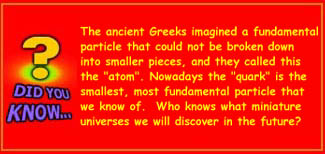![[Chemistry]](../inline/chemistr.gif)
![[Chemistry]](../inline/chemistr.gif)
![]()
|
This project idea comes to you from Venture Engineering and Science Camp in Hamilton, Ontario. |
![[Venture Engineering and Science Camp]](../../../logos/venture.gif)
|
 Everything in the world is made up of millions of tiny atoms.
Atoms are made up of even smaller particles called electrons, protons, and
neutrons. Protons and neutrons are found in the centre of each atom, and
the electrons circle around the protons. Each electron has an electric
charge, and this charge, which is negative, is the fundamental cause of
electricity. Protons have a positive charge and neutrons have no charge.
Everything in the world is made up of millions of tiny atoms.
Atoms are made up of even smaller particles called electrons, protons, and
neutrons. Protons and neutrons are found in the centre of each atom, and
the electrons circle around the protons. Each electron has an electric
charge, and this charge, which is negative, is the fundamental cause of
electricity. Protons have a positive charge and neutrons have no charge.
Current electricity is produced by electrons on the move in a continuous, unbroken path or "circuit". It can only exist in a conductor, which is a material such as a metal that allows electrons to pass through it. To make these electrons move, a source of energy or a driving force is needed. Chemical energy is the source of power in a battery-powered circuit.
Background Terms:
![[Kids with batteries]](inline/circuits.jpg) When you add salt to the vinegar, the salt molecules separate (technically called "dissociate") into their component parts: positive sodium ions and negative chloride ions. (The chemical name for salt is sodium chloride because it is made up of sodium and chloride atoms.) The sodium chloride is called the electrolyte because it provides these charged atoms, called ions. In this activity, two electrodes (the pennies and the washers) are dipped into the electrolyte. The electrodes, which are metals that can conduct electricity, are attached to the battery by wires. As in magnets, opposite charges attract. Since the non-copper metal washer (zinc, nickel, etc.) is connected to the negative end of the battery, the positive copper ions are attracted to the non-copper metal, producing a copper coating on it. This process is called electroplating.
When you add salt to the vinegar, the salt molecules separate (technically called "dissociate") into their component parts: positive sodium ions and negative chloride ions. (The chemical name for salt is sodium chloride because it is made up of sodium and chloride atoms.) The sodium chloride is called the electrolyte because it provides these charged atoms, called ions. In this activity, two electrodes (the pennies and the washers) are dipped into the electrolyte. The electrodes, which are metals that can conduct electricity, are attached to the battery by wires. As in magnets, opposite charges attract. Since the non-copper metal washer (zinc, nickel, etc.) is connected to the negative end of the battery, the positive copper ions are attracted to the non-copper metal, producing a copper coating on it. This process is called electroplating.
Electroplating is more than a century old. You can see many examples of electroplating around you. The "tin can", for example, is actually a steel can that has been plated with a protective layer of tin. Nowadays many "tin cans" are actually plated with chromium instead of tin, because it is more resistant to corrosion. New applications for electroplating are being experimented with right now. To replace worn or damaged human joints by synthetic ones, doctors need strong, light, and resistant materials. One material that has shown promise in experiments is made by plating a light-weight alloy with a thin coat of tantalum.
Physics | Chemistry | Biology | Engineering | Computer Science | Understanding Science and Technology